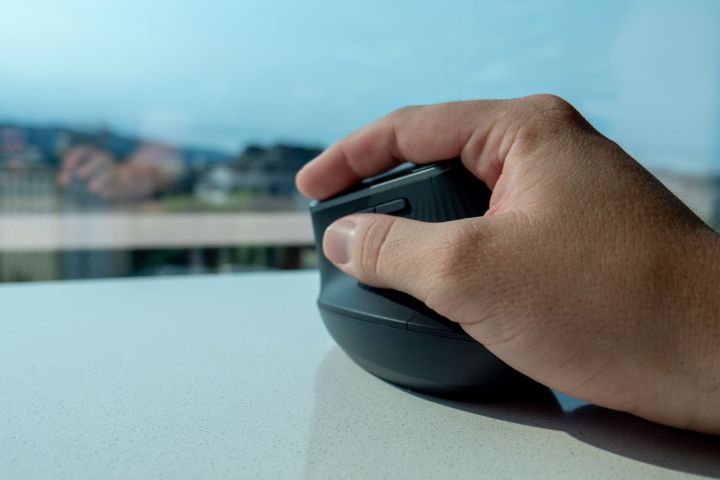
Even if you’re using one of the best wireless mice, heavy PC and laptop use can lead to wrist fatigue, wrist pain, and even conditions like carpal tunnel and repetitive strain injury. Although it’s hard to eliminate that problem entirely, you can massively improve your wrist health with a capable ergonomic mouse.
From vertical mice to trackballs, adaptive customizable designs, and more, here are the best ergonomic mice in 2024.


Logitech MX Master 3s
The best ergonomic mouse for most people
Jump to details
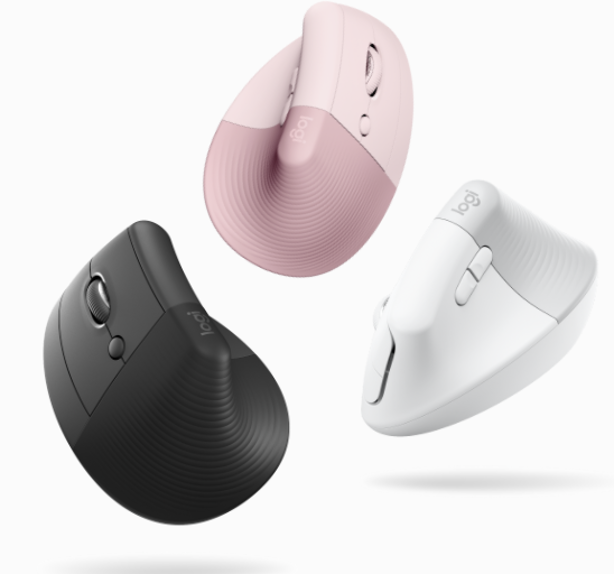
Logitech Lift Vertical Ergonomic Mouse
Best ergonomic mouse for smaller hands
Jump to details

Anker Wireless Vertical
Best ergonomic mouse for larger hands
Jump to details


Microsoft Adaptive mouse
Best ergonomic mouse for accessibility
Jump to details

Kensington Pro Fit Ergo TB550 Trackball
Best trackball mouse
Jump to details

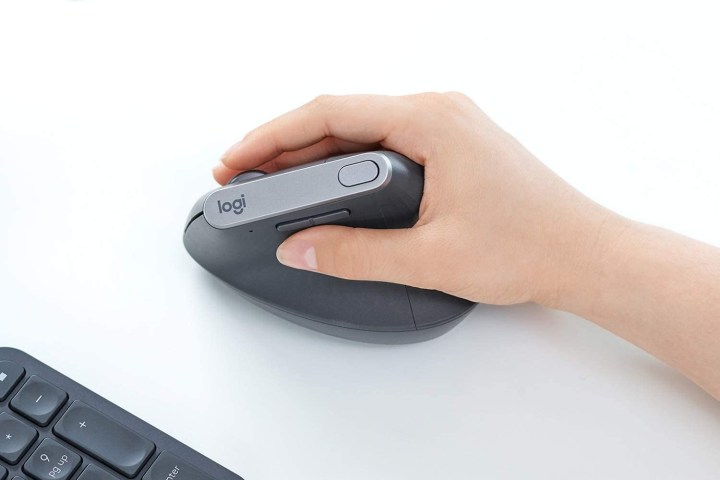
Logitech MX Vertical
The best vertical ergonomic mouse
Pros
- One of the best vertical designs
- Rubber and aluminum frame
- Wired and wireless options
Why you should buy this: Vertical mice give the most comfort long term, and this one is the best of the best.
Who it’s for: People who will be scrolling on a computer screen for most of their day.
Why we picked the Logitech MX Vertical:
Building off developments in its other ergonomic mice, Logitech’s MX Vertical is the company’s first real attempt at a tall mouse that tackles the problems commonly associated with long-term mousing discomfort. Logitech claims it can offer up to a 10% reduction in muscle strain with extended usage. While that sort of metric is hard to test accurately, we did find it supremely comfortable during our testing. Better yet, it’s intuitive and easy to get to grips with.
With a hefty but not overblown tilt angle of 57 degrees, the MX Vertical remains functional as an everyday mouse while still providing the benefits of a more ergonomic peripheral. Its natural wrist positioning forces you to rest your hand in a more conducive to long-term wrist health.
On top of all of its ergonomic features, this mouse looks good, too. Its combination of rubber and aluminum gives it a premium feel and finish that, for $100, feels well worth it to enjoy the benefits of ergonomic mousing. With wired and wireless options over Bluetooth (up to four months of battery life) and USB, it should work fine while you’re on the move or when tethered to a desk. Despite stiff competition, the Logitech MX Vertical steams ahead as the best ergonomic mouse you can buy today.

Logitech MX Vertical
The best vertical ergonomic mouse
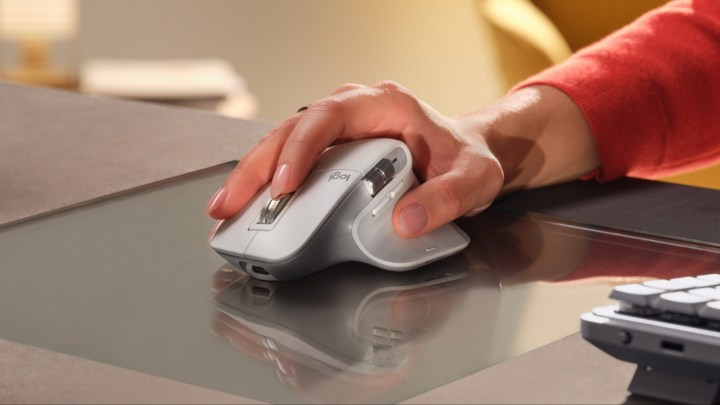
Logitech MX Master 3s
The best ergonomic mouse for most people
Pros
- Sleek look
- Extremely comfortable
- Side scroll wheel is beyond convenient
- Notched or free-spin scroll wheel
- Incredible battery life
Cons
- Thumb rest gets dirty
- May be too heavy for some
Why you should buy this: It’s a modern, comfortable ergonomic mouse.
Who it’s for: People who don’t want a vertical mouse, but still need something that is ergonomic.
Why we picked the Logitech MX Master 3s:
The Logitech MX Master 3s is very similar to the MX Master 3 in terms of appearances. However, the MX Master 3s stands out thanks to various enhancements. It features quieter left- and right-click buttons, an improved sensor with a broader CPI range of 8000Hz, and it utilizes Logitech’s latest USB Bolt Receiver, while the earlier MX Master 3 employs Logitech’s older Unifying USB Receiver.
The MX Master 3s is pretty durable and one of the best ergonomic mice on our list as it’s made of stainless steel, not the traditional rubber material. It even works with multiple PCs, Macs, and tablets thanks to a handy switch on the bottom. The best part about Logitech’s MX Master series is the MagSpeed electromagnetic scroll wheel that offers scroll speed of up to 1,000 lines per second for excellent accuracy. It comes with two modes — a magnetic jump-scrolling mode for better control and a free-spinning mode that offers smooth and near-silent scrolling. Charging is done via USB-C and Logitech claims standby battery backup of up to 70 days.

Logitech MX Master 3s
The best ergonomic mouse for most people

Logitech Lift Vertical Ergonomic Mouse
Best ergonomic mouse for smaller hands
Pros
- A more affordable Logitech option
- Designed for comfort
- Left-handed option available
Cons
- Made mostly for small to medium hands
Why you should buy this: It’s a premium ergonomic mouse with a budget price tag.
Who it’s for: Those who love Logitech mice and want one designed specifically for good hand posture.
Why we picked the Logitech Lift:
The Lift is a mouse made for maximum comfort, a wireless model with a sculpted design made to help your hand rest in the most natural “handshake” position possible. It also manages to make room for six buttons total, including back/forward buttons and a middle click option. It’s also more affordable than other Logitech picks, making it a good choice for those who like the Logitech approach but would rather save money, too.
The optical sensor in the Lift has a 400 to 4000DPI range and is adjustable in 100DPI increments. It operates on a single AA battery that can last up to two years before it needs replacing. It’s also available in a left-handed version. The only downside worth noting here is that the mouse is specifically made for small and medium hands, so if your hands are on the larger side you may not find it a good fit.

Logitech Lift Vertical Ergonomic Mouse
Best ergonomic mouse for smaller hands

Anker Wireless Vertical
Best ergonomic mouse for larger hands
Pros
- Multiple DPS options
- Five buttons for assigning commands
- Power-saving mode
- Affordable pricing
Cons
- May be too large for some users
Why you should buy this: If you need an alternative to the Logitech MX Vertical.
Who it’s for: Folks who want an accurate vertical mouse with a solid design.
Why we picked the Anker Wireless Vertical:
Your wrists don’t care how expensive an ergonomic mouse is, which can be a problem for those who don’t want to spend a lot of cash on a mouse replacement. Fortunately, Anker’s solution is a great vertical ergonomic model that’s as affordable a mouse as you can find. It offers options for 800, 1,200, or 1,600 DPI optical tracking that you can switch between to find the sensitivity that you like and includes built-in previous/next buttons for easy browsing — although they, like all five buttons on the mouse, can be mapped to different commands if you prefer.
While the Anker Wireless Vertical runs on two AAA batteries, it does help conserve battery life with a power-saving mode that it will enter after eight minutes without use. While we’re fans of the design and the price is amazing, we should note that this mouse is a bit large. If you have especially small hands, it might prove not easy to use. It’s also right-handed only.

Anker Wireless Vertical
Best ergonomic mouse for larger hands
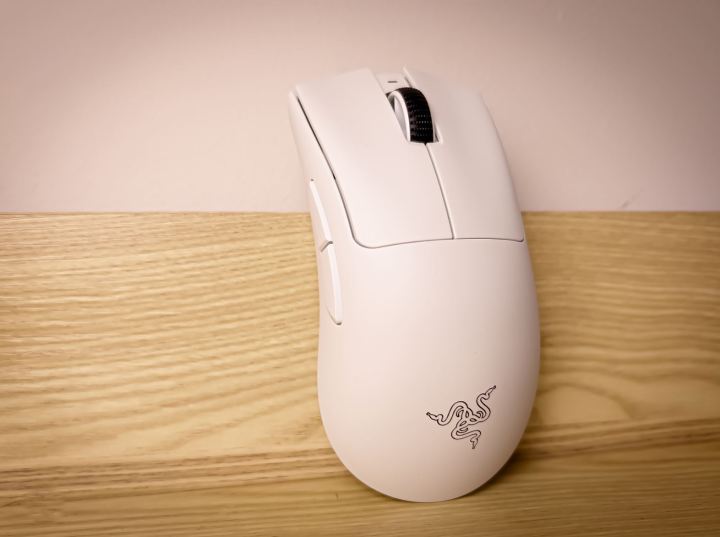
Razer DeathAdder V3 Pro
Best ergonomic mouse for gaming
Pros
- Perfect for palm grip
- Fantastic battery life
- Lightweight for its size
- PTFE feet
- Slight tweaks to design look great
Why you should buy this: If you’re a gamer in need of a comfortable palm-grip mouse, this is one of the best ergonomic options.
Who is it for: Gamers who need a nimble, sensitive mouse.
Why we picked the Razer DeathAdder V3 Pro:
The Razer DeathAdder V3 Pro is one of the best and lightest ergonomic gaming mice. It has been designed with recommendations from top esports pros, and is said to be 25% lighter than its predecessor at just 63 grams. It is also one of the best palm grip-friendly mice, which makes for an extremely comfortable experience.
The mouse features Razer’s Focus Pro 30K Optical sensor with up to 30,000 DPI sensitivity (not that one would need such high sensitivity) that offers three levels of liftoff customization, 26 steps of asymmetrical cutoff and the ability to track on glass (at least 4 mm thick). Besides that, you get up to a 4000Hz polling rate, high-quality optical switches for speedy inputs, PTFE feet for smoother operation, and the option to add grip tape for ultimate control.

Razer DeathAdder V3 Pro
Best ergonomic mouse for gaming

Microsoft Adaptive mouse
Best ergonomic mouse for accessibility
Pros
- Can be customized to a user’s specific needs
- Range of 3D-printed and printable accessories
- Bluetooth connectivity works with most devices
- Accurate and responsive sensor with 6,000-DPI range
Cons
- Requires accessories for full functionality
Why you should buy this: It’s customizable for a wide range of mobilities and capabilities.
Who it’s for: Those with limited mobility or specific input needs that can’t be addressed by traditional mice.
Why we picked the Microsoft Adaptive Mouse:
The Microsoft Adaptive Mouse is, by itself, a tiny, capable mouse that’s great for travel and can be configured to offer multiple functions for each button, depending on how long you hold them down. The real selling point of this design, though, is how well it interacts with additional accessories and 3D-printed extras. You can add a larger mouse body to it, or add a range of options that adapt this mouse to the shape and design that you need.
Everyone’s mobility is different, and if you have specific needs for how a mouse should be shaped or interacted with, this mouse can be customized to make it comfortable and effective for you. You can print the accessories yourself, or purchase them through a third-party printing company. That does mean added expense andthe need to tweak and play around with this mouse to get the right feel and design for you, but the potential is there for this mouse to be a useful tool for just about anyone with specific ergonomic and mobility needs.

Microsoft Adaptive mouse
Best ergonomic mouse for accessibility

Kensington Pro Fit Ergo TB550 Trackball
Best trackball mouse
Pros
- Ergonomic shape is very supportive
- Classic trackball thumb control is intuitive
- Strong build-quality
- Supports 2.4GHz and Bluetooth connectivity
- Four-month battery life
- Also available with a finger-ball
Cons
- Limited sensitivity
- Only right-hand version avalable
Why you should buy this: It offers comfortable trackball control.
Who it’s for: Trackball veterans, or those who want to switch from wrist to thumb controls for their mouse.
Why we picked the Kengsington Pro Fit Ergo TB550:
Trackballs aren’t for everyone, but if you like them, or are keen to try controlling your mouse pointer with your thumb rather than your wrist, the Kensington Pro Fit Ergo TB550 is a great option. It has a comfortable, ergonomic design — though only for right-handed users — and the trackball is large and easy to control with your thumb. There’s a finger-control version, too, but the design is quite different.
This is a wireless mouse with a built-in rechargeable battery that should last for a few months at a time (Kensington rates it at four months). It works over Bluetooth or with the 2.4GHz wireless dongle, and you can use it while plugged in with a wired, too, so that you can use it while it recharges.
There are five buttons, giving you lots of control options, and they can be remapped in the included software. The only real downside is the sensor’s sensitivity is limited to 1,600 DPI. That’s less of a problem with a trackball, but does mean super fast movements aren’t quite as easy to achieve.

Kensington Pro Fit Ergo TB550 Trackball
Best trackball mouse

Contour Design Unimouse
Best adjustable mouse
Pros
- Customizable angle and thumb rest
- Six programmable buttons
- Multiple cursor speed options
Cons
- The design means this mouse isn’t as durable as some options
Why you should buy this: It’s one of the most adjustable mice you can find.
Who it’s for: Users who need just the right position to avoid pain.
Why we picked the Contour Design Unimouse:
If you have wrist pain, joint issues, arthritis in your fingers, or similar problems, it may be hard to find just the right grip to avoid pain. Contour Design has a solution for you – a mouse that’s fully adjustable, allowing you to choose the angle of the grip and position of your thumb until you find something that works.
The innovative design isn’t the only impressive thing here, either: The mouse has 10 cursor speed options and six programmable buttons. If you haven’t had much success with ergonomic mice in the past, it may be a good idea to try one that allows you to customize the position so easily.

Contour Design Unimouse
Best adjustable mouse
Frequently Asked Questions
How do I choose an ergonomic mouse?
Try the mouse out in person, if possible, or check reviews and overall features when making your choice. Decide early on if you want a vertical mouse (where your hand is in a handshake position, common for those with wrist issues) or a more traditional horizontal mouse with added support. Where are your pain points, and what positions relieve them? Some models specialize in thumb relief so your thumb doesn’t get frozen after a long day of work, while others, like trackballs, focus on helping people with shoulder pain. Ultimately, you’re the one best qualified to make the decision.
Can ergonomic mice help with carpal tunnel?
This is where vertical mice can be particularly useful. A vertical mouse like our Anker wireless model above puts your wrist and hand in a handshake-like position while you work. For those with carpal tunnel and related wrist issues, that position tends to feel more natural and less painful and is certainly worth a try if you’ve been struggling.
Are trackball mice considered ergonomic?
A trackball mouse allows you to use short, gentle finger and palm (or sometimes only thumb) movements to control the cursor. This is helpful for those recovering from injuries or faced with accessibility issues as well as those suffering from shoulder pain that comes with more exaggerated movements. It may also be helpful if your fingers suffer from bad arthritis. Trackpads are another alternative worth looking into.
Ambidextrous mice vs. ergonomic: What’s the difference?
An ambidextrous mouse has a neutral design that allows you to use it with your right or left hand as needed (not to be confused with mice that are specifically left-handed). An ergonomic mouse is designed to reduce necessary movement and encourage more comfortable, healthier hand positioning. The issue is that those two goals are often incompatible, so it’s more difficult to find an ergonomic mouse that’s also ambidextrous. If you are primarily interested in mouse performance, not reducing pain, then try them both to see which you like best.
Is an ergonomic mouse worth it?
There is no magic mouse shape that will solve every issue — much of it is personal preference and what your goals are. That being said, various ergonomic mouse shapes have garnered plenty of praise for reducing pain and managing injuries, so if you are struggling we certainly suggest looking into your ergonomic options. And don’t stop with a mouse! The right ergonomic keyboard with a wrist pad may also help.
Is a vertical mouse ergonomic?
Vertical mice are designed to be held in the “handshake” position we have previously mentioned. That’s a more natural position for your wrist and can help prevent certain types of strain. Several of our picks have this vertical design, but it’s not the only kind of ergonomic mouse available, and not everyone likes how they feel.
Is an ergonomic mouse good for gaming?
It can help reduce the risk of gaming-related injuries like carpal tunnel. Of course, you’ll also have to get used to the feeling of a new kind of mouse as you play, which may take some time. Otherwise, they can be entirely suitable for gaming. If you have any kind of injury related to repetitive motions you make while gaming, talk with a doctor about them and the best ways to prevent them or recover.
Is a flat mouse ergonomic?
Flat mice aren’t usually considered ergonomic. Their shape requires a lot of wrist movement to use, which may create wrist problems over time. Ergonomic mice tend to have a different shape that encourages more fluid movement with less wrist activity.
Are you also a bit of a gamer? Check out our guide to the best gaming mice. There are some ergonomic options there, too.
Read the full article here













